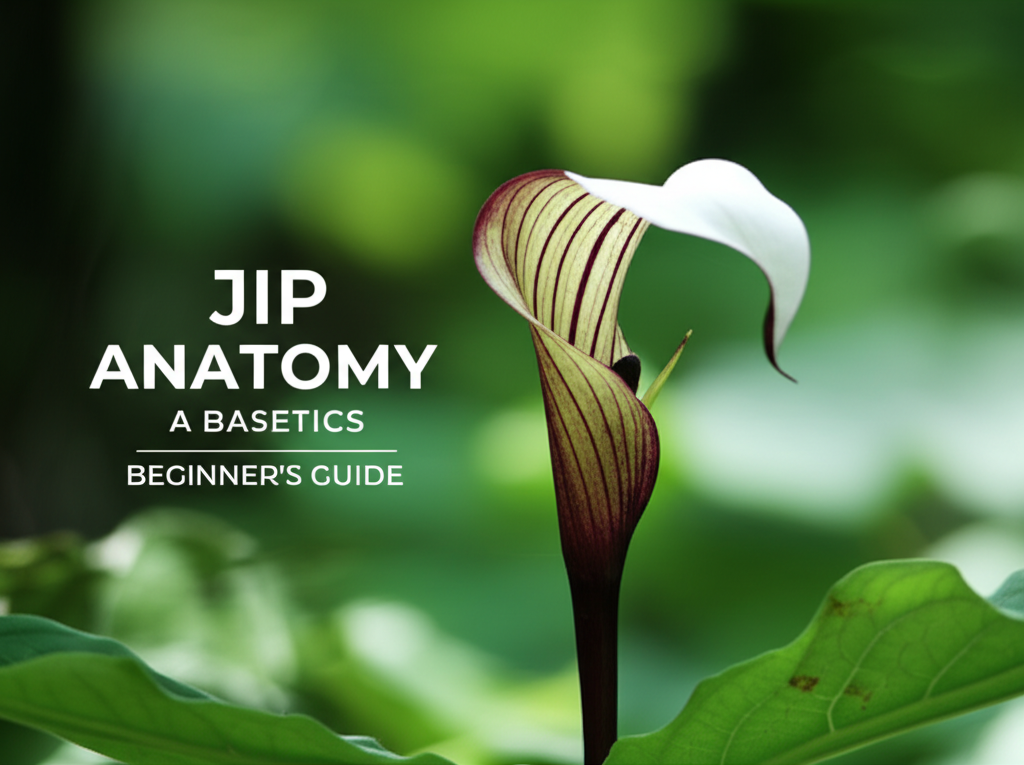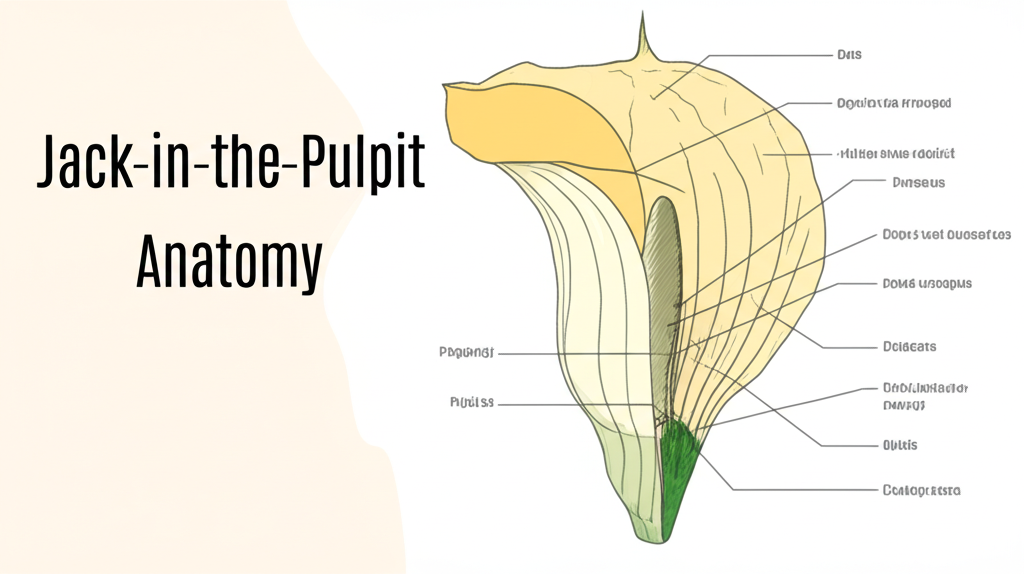The Mystical Jack-in-the-Pulpit: More Than Just a Pretty Face
The Jack-in-the-Pulpit (Arisaema triphyllum) is a plant that sparks curiosity and wonder. Its distinctive, hooded bloom has earned it a place in folklore and a reputation for being a bit of a botanical puzzle. Far from being just a visually striking plant, its anatomy is a testament to the ingenuity of nature. This guide is designed for beginners, demystifying the various parts of the Jack-in-the-Pulpit, from its underground storage organ to the intricate structures that protect its reproductive parts. Understanding its anatomy not only enhances appreciation for this woodland gem but also sheds light on its ecological role and survival strategies.
A Glimpse Below the Surface: The Corm

Before we delve into the above-ground spectacle, it’s crucial to understand the foundation of the Jack-in-the-Pulpit: its corm. This fleshy, underground stem serves as a vital storage organ, akin to a bulb or tuber, but with a distinct structure.
The Corm’s Role in Survival
The corm is the plant’s lifeline. It stores carbohydrates and nutrients, allowing the Jack-in-the-Pulpit to survive harsh winter conditions and the dry spells of summer. This stored energy is crucial for initiating new growth each spring and for producing flowers and subsequent seeds.
Corm Development and Budding
Corms typically start small and gradually enlarge over time. They possess terminal buds at the top from which the above-ground growth emerges and lateral buds that can give rise to new corms, enabling the plant to spread vegetatively. Mature corms can be quite substantial, often resembling a flattened sphere or a flattened bulb.
The Heart of the Matter: The Spadix and Spathe
The most iconic feature of the Jack-in-the-Pulpit is undoubtedly its flower structure, which is a highly modified inflorescence. It consists of two primary components: the spadix and the spathe.
The Spadix: The Preacher in the Pulpit
The spadix is the central, upright structure, often resembling a club or a finger-like projection. This is where the actual flowers are located, though they are not visually prominent in the way we typically think of flowers.
- Fertile Flowers: The lower portion of the spadix is densely packed with tiny, fertile flowers. These are the reproductive units of the plant.
- Staminodes: Above the fertile flowers, the spadix is adorned with sterile, often filamentous structures called staminodes. Their exact function is debated, but they are thought to play a role in attracting pollinators or preventing self-pollination.
- Terminal Appendix: The very tip of the spadix culminates in a sterile, often club-shaped or elongated appendage. This is sometimes referred to as the “oversized pulpit” or the “preacher’s nose.”
The Spathe: The Enclosing Pulpit
The spathe is the large, leaf-like structure that enfolds the spadix, creating the distinctive “pulpit” appearance. It’s a highly modified bract that serves to protect the developing reproductive organs and, importantly, to direct pollinators.
- Shape and Coloration: The spathe is typically hooded, with two distinct “lobes” or “lips.” The upper, larger lobe arches over the spadix, forming the roof of the pulpit. The lower lobe is often folded forward, creating the front of the pulpit. The spathe’s coloration can vary, ranging from green to striped with purple or brown, often intensifying with age or in response to environmental factors.
- Pollinator Attraction: The spathe’s coloration and structure are believed to play a significant role in attracting insects, particularly flies and gnats, which are the primary pollinators.
The Supporting Cast: Peduncle and Petiole
While the spadix and spathe command attention, other structures are essential for their support and the plant’s overall form.
The Peduncle: The Stalk of the Flower
The peduncle is the stalk that supports the entire inflorescence (spadix and spathe). It emerges from the top of the corm and extends upwards, holding the “pulpit” aloft.
The Petiole: The Leaf Stalk
The petioles are the stalks that attach the compound leaves to the stem. Jack-in-the-Pulpit typically has one to three leaves per plant, each typically divided into three leaflets. The petioles are robust and contribute to the plant’s upright habit.
The Leaves: More Than Just Greenery
The leaves of the Jack-in-the-Pulpit are trifoliate, meaning each leaf is divided into three distinct leaflets. These leaves are essential for photosynthesis, the process by which the plant converts light energy into chemical energy.
Leaflet Morphology
The leaflets are generally ovate to lanceolate in shape, with smooth or slightly toothed margins. Their size and shape can vary depending on the age and vigor of the plant.
Dioecious Nature and Leaf Arrangement
Interestingly, Jack-in-the-Pulpit is dioecious, meaning individual plants can be either male or female. The sex of the plant can be influenced by its age and vigor, with younger plants often being sterile or male, and older, more robust plants developing into females capable of producing berries. The arrangement of the leaves often provides a clue to the plant’s reproductive status. Plants with two leaves are typically male or sterile, while plants with three leaves are more likely to be female and bear fruit.
The Reproductive Cycle: From Flower to Fruit
The ultimate purpose of the Jack-in-the-Pulpit’s elaborate floral structure is reproduction. The plant has a fascinating reproductive strategy that involves both insect pollination and seed dispersal.
Pollination Mechanism
The spadix, particularly its staminodes and the scent it may emit, attracts small insects. These insects are drawn into the spathe, which often acts as a trap. The downward-pointing hairs on the interior of the spathe can prevent insects from easily escaping, forcing them to linger and facilitate pollination. Some species may also employ a “heat generation” mechanism, warming the spathe to further attract insects. Once pollination is complete, the insects are typically able to find their way out.
Fruit Development: The Red Berries
Following successful pollination, the fertile flowers on the spadix develop into attractive, bright red to reddish-orange berries. These berries are clustered together on the spadix, presenting a visually appealing display.
- Toxicity and Edibility: While visually tempting, the berries and other parts of the Jack-in-the-Pulpit contain calcium oxalate crystals, which can cause irritation and burning if ingested. They are not considered edible for humans in their raw form.
- Seed Dispersal: The berries serve as a food source for various woodland animals, such as birds and small mammals. As these animals consume the berries, they aid in dispersing the seeds, contributing to the plant’s propagation.
Key Facts and Comparison of Jack-in-the-Pulpit Anatomy
To summarize the essential components of the Jack-in-the-Pulpit’s anatomy, let’s look at this comparative table.
| Structure | Primary Function | Description | Beginner Recognition Tip |
|---|---|---|---|
| Corm | Storage and Perennation | Fleshy, underground stem | The “root” system from which growth emerges |
| Spadix | Reproductive organ housing flowers | Upright, club-shaped or finger-like structure | The “preacher” or “jack” |
| Spathe | Protection and pollinator attraction | Hooded, leaf-like structure enclosing the spadix | The “pulpit” or “hood” |
| Peduncle | Support for inflorescence | Stalk of the spadix and spathe | The stem holding the pulpit |
| Petiole | Leaf stalk | Connects compound leaves to the stem | Stalks of the trifoliate leaves |
| Leaves | Photosynthesis | Trifoliate (three leaflets) | The green, fan-like structures |
| Berries | Seed dispersal | Bright red, clustered fruits | The colorful “necklaces” after flowering |
Understanding Variations and Growth Stages
The appearance of a Jack-in-the-Pulpit can vary significantly based on its age, sex, and environmental conditions. Recognizing these variations is key to a comprehensive understanding.
Male vs. Female Plants
As mentioned, Jack-in-the-Pulpit is dioecious. The subtle differences between male and female plants are primarily related to their reproductive capacity. Female plants typically have a longer spadix with more fertile flowers, leading to the development of more berries. Male plants often have shorter spadices with more staminodes.
Juvenile vs. Mature Plants
Younger plants may produce only a single leaf and might be sterile or male. As the plant matures and accumulates resources in its corm, it will develop more leaves and have a greater chance of becoming female. The spathe’s coloration can also be more pronounced in older, more vigorous specimens.
Step-by-Step Breakdown: Anatomy and Its Ecological Significance
Let’s break down the Jack-in-the-Pulpit’s anatomy and consider its importance in the woodland ecosystem.
| Anatomical Part | Step in Function/Purpose | Pros (Ecological Advantage) | Cons (Potential Vulnerabilities) |
|---|---|---|---|
| Corm | 1. Stores energy. 2. Survives winter dormancy. 3. Initiates spring growth. |
Resilience to harsh conditions, long-term survival | Vulnerable to soil disturbance and over-harvesting |
| Spadix | 1. Houses tiny flowers. 2. Attracts pollinators via scent/structure. 3. Contains fertile and sterile parts. |
Efficiently attracts and guides pollinators | Requires specific pollinator types (flies, gnats) |
| Spathe | 1. Protects developing flowers. 2. Creates a visual attractant. 3. Directs pollinators into the “trap.” |
Effective in capturing and retaining pollinators | Can be damaged by physical means; relies on visual cues |
| Leaves | 1. Photosynthesis. 2. Support the plant’s structure. |
Provides energy for growth and reproduction | Vulnerable to herbivory by slugs and insects |
| Berries | 1. Develop from fertilized flowers. 2. Attract wildlife for seed dispersal. 3. Contain seeds for new generations. |
Ensures propagation and spread of the species | Toxicity prevents self-consumption; relies on animal vectors |
Conclusion: A Masterpiece of Woodland Adaptation
The Jack-in-the-Pulpit, with its intricate and specialized anatomy, is a true marvel of the plant kingdom. From the unassuming corm hidden beneath the soil to the visually arresting spathe and spadix, each part plays a vital role in the plant’s survival, reproduction, and interaction with its environment. For beginners, understanding these components unlocks a deeper appreciation for this enigmatic woodland flower. It’s a reminder that even the most peculiar forms in nature often serve a sophisticated purpose, showcasing the elegant solutions that evolution has devised for life’s enduring challenges. Observing and learning about the Jack-in-the-Pulpit’s anatomy is an enriching experience, inviting us to look closer and marvel at the wonders of our natural world.


